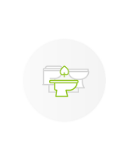If you’re searching for the best toilet for off-grid living or a tiny home compost toilet in NZ, the ™ Separera Mini urine-diverting compost toilet deserves your attention. This sleek, waterless toilet is designed for New Zealand customers living in tiny homes, off-grid cabins, and vanlife setups, combining modern comfort with sustainable waste management. In this detailed review, we’ll explore the EcoLet Separera Mini’s key features, design, performance, and environmental benefits. We’ll also compare it to simpler alternatives like porta-loo style RV toilets and DIY bucket systems – and show why the EcoLet is a more sustainable, long-term solution for off-grid sanitation in New Zealand.
Key Features of the EcoLet™ Separera Mini
- Urine-Diverting, Waterless Design: The EcoLet™ Separera Mini is a completely waterless dry toilet, so you never need to flush or waste precious water. Its smart bowl design separates liquids and solids, keeping the solid waste dry for easier composting and virtually no odour. This urine-diverting feature not only reduces smell but also means you’re saving water every single time you don’t flush – a huge advantage for off-grid living in drought-prone areas.
- Compact & Lightweight: With a slim footprint of about 50×40 cm and an empty weight of around 10 kg, the Separera Mini is small and portable enough for tiny bathrooms and mobile setups. It looks and feels like a normal porcelain toilet, yet it’s much lighter (no heavy ceramic). This compact size makes it ideal for motorhomes, caravans, boats, and tiny houses where space is at a premium.
- Modern Aesthetic & Sturdy Build: The toilet has a shiny, high-gloss finish that mimics porcelain, giving it a clean, modern look that blends into any bathroom style. Despite the lightweight build, it features a sturdy toilet seat and lid for comfort and durability. The unit is moulded from high-quality ASA/polypropylene plastic, which is durable and easy to clean. In other words, you get the appearance of a standard toilet without the bulk or fragility.
- Automatic “Chamber Screen”: One ingenious feature is the integrated chamber screen (trap door) that automatically opens when you sit and closes when you stand up, concealing the solids bin. This means no one has to see the contents inside, and it helps contain odours. The screen “hides the waste when not in use,” improving hygiene and aesthetics.
- Dual 15 Litre Waste Chambers: The EcoLet™ Mini uses a batch composting approach: it comes with two interchangeable 15 L solid waste bins. You line a bin with a compostable bag, and when it’s full, you simply cap it and swap in the spare bin – minimising downtime and mess. 15 L capacity is sufficient for up to two people using the toilet full-time (solids typically need emptying about once every 1–2 weeks for 2 users). This small batch system means each bin of waste can be set aside to compost further in an external pile if you choose, turning into a nutrient-rich resource over a few months. The toilet even comes with 25 compostable liner bags and a bottle of enzyme spray to get you started.
Two Models (Urine Handling Options): Buyers can choose between two versions of the Separera Mini: a Urine Extraction model or a Urine Container model. The Urine Extraction (UD-S) version drains urine out through a hose to an external location (such as a jerry can, a soak pit, or a larger holding tank). This is great for permanent tiny house installations or RVs with a plumbed holding tank. The Urine Container (UD-C) version, on the other hand, has an internal 8 L urine bottle that collects liquids for truly self-contained use (you’d just pull out and empty the bottle every few days). Both methods keep liquids separate from solids, which is key to odor control and easy maintenance. In either case, you can dilute collected urine and use it as fertiliser on non-food plants – returning nutrients to nature instead of sending wastewater to a septic or sewer.
12V Ventilation for Odour Control: The EcoLet™ Separera Mini features an integrated 12-volt ventilation fan that runs continuously to evacuate moisture and odours through a vent hose. This low-power fan (only ~5 W draw, so it’s very battery/solar-friendly) creates airflow that keeps the toilet odorless by drying out waste and pulling any smells outside. Users report that with the fan running and the urine diverted, there is no unpleasant smell in the bathroom – you can “enjoy a fresh and pleasant bathroom experience” even with composting waste present. The fan is quiet and can be turned off when not needed (for example, if you’ll be away for a few days) to conserve power. In short, the EcoLet™ is designed for odourless operation 24/7, crucial when your toilet is inside a small space like a cabin or camper.
Easy Installation: Installing the EcoLet™ Mini is straightforward, even DIY-friendly. The unit sits on the floor (no need to cut a hole for a blackwater tank as with flush toilets) and just requires a vent pipe run outside (a vent kit with pipes is included) and a 12V connection for the fan. If using the urine-extraction model, you’ll also hook up the urine drain hose to your chosen outlet (tank, soakaway, etc.). The included vertical vent kit allows you to vent through the roof to meet building codes (in NZ, a vent 0.6 m above roofline is recommended for any toilet vent). Because the unit is compact and all-in-one, you have flexibility to install it in tiny bathrooms, sheds, or even retrofitted into vans relatively easily.
Minimal Maintenance: One of the EcoLet’s™ selling points is how simple it is to use and maintain day-to-day. There’s no complicated mechanism – it’s a passive composting system, so no turning or mixing is required on this unit. Using it is as easy as sitting down (always sit to use, which is typical for separating toilets). Toilet paper can go into the solids bin without issues. After each solid use, it’s wise to sprinkle a bit of peat moss or sawdust (or the provided enzyme spray) as a cover, which helps the composting process and further suppresses odors (the manufacturer calls this the “Cover It Up” method). Beyond that, the main upkeep is: empty the solids bin every week or two (for full-time use) and either set it aside to compost or dispose of it responsibly; empty the urine bottle every few days if you have the internal container model; and rinse the urine bowl weekly with hot water to prevent urine salt build-up. Cleaning the unit is done with mild detergent – no harsh chemicals needed. All these tasks are easy and quick. In exchange for a few minutes of maintenance each week, you get a self-contained toilet that requires no plumbing and no expensive consumables. It’s a very fair trade-off for off-grid independence.
Design and Build Quality
The EcoLet™ Separera Mini has been thoughtfully designed to balance form and function. At first glance, you might not even realize it’s a composting toilet – it looks like a regular modern toilet with a white porcelain-like exterior and a standard-shaped seat. This is a big plus for tiny homeowners who want their bathroom to feel “normal” and inviting. Build quality on the EcoLet™ is solid: the pedestal and lid feel sturdy, and the high-gloss ASA/ABS plastic is durable, non-porous, and easy to wipe clean. Users have noted that despite being lightweight, the unit doesn’t feel flimsy. It’s built to handle the same daily use a household toilet would, but without heavy ceramics. Inside the toilet, the design is optimized for simplicity and cleanliness. The bowl has a deep, ergonomic urine diverter at the front to catch liquids without splash-back – an important detail that many cheaper designs lack. Solids drop directly into the lined chamber below. The automatic chamber screen (or trap door) is a clever mechanism that keeps you from ever having to look at the waste except when you’re servicing the unit. It opens only when you’re seated and closes before you stand up, meaning the waste bin stays covered and out of sight. This not only spares you the view, but also helps contain odors and flies. It’s a small quality-of-life feature that makes a big difference in everyday use. In terms of size, the Separera Mini sits at roughly 50 cm tall (standard chair height) so it’s comfortable to sit on, even for adults. Its compact footprint (about 38 cm x 30 cm of floor space required) is excellent for tight bathrooms. For example, van lifers have successfully installed this unit in sprinter van builds without sacrificing too much space. The fact that it weighs only ~10 kg means it’s easy to maneuver into place and can be installed on upper floors or mobile platforms without structural concerns. Yet, once bolted down, it’s stable. The design also includes little touches for convenience, like a quick-release seat for cleaning and a power plug for the fan that can disconnect easily if you need to remove the top section. Overall, the EcoLet’s™ design is user-centric: it feels like a “real” toilet, it’s easy to keep clean, and it’s built robustly enough for life on the move.
Performance and Odor Control
When it comes to real-world performance, the EcoLet™ Separera Mini excels in providing a pleasant, odor-free toileting experience – arguably the most critical factor for any composting toilet. Thanks to its urine-diverting system and continuous ventilation, users report that odors are effectively eliminated during use. The solid waste remains relatively dry (since urine is separated), which greatly cuts down the smell and fosters aerobic decomposition. The constant air flow drawn by the 12V fan keeps the contents drying and vented outside, so your bathroom stays fresh. In practice, a well-installed EcoLet™ (with vent pipe properly run vertically) is virtually odorless in the room. If you’ve only ever used chemical toilets or bucket toilets, this lack of smell can be a revelation – no “outhouse” stink at all. Just be sure to keep the fan running and ensure there are no air leaks in the vent hose connections (the unit comes with clamps and seals to secure the vent). The EcoLet™ Mini’s capacity is suitable for individuals, couples, or small families on a full-time basis. As mentioned, with two people using it full-time, you’ll fill a 15 L solids bin in roughly 1–2 weeks. This interval can stretch longer for a single user or intermittent use (e.g. a bach/holiday cabin). The good news is swapping out the full bin is quick and clean: you lift the top section, tie off the compostable bag lining the bin, put the lid on the bin and set it aside, then insert the second bin and you’re back in action in minutes. There’s no mounding or stirring needed inside this toilet; it’s essentially a holding chamber for solids until you empty it. Some users will keep the full bin in a designated outdoor composter to finish breaking down for a few months, whereas others might bag and dispose of it (per local regulations). Either way, the handling is manageable. The urine container (if you have that model) will hold about 8 L, which for two people means emptying every other day or so – similar to emptying a typical porta-potti cassette, but without the foul chemical mix. If that sounds too frequent, opting for the urine-extraction model is wise; with urine plumbed to a larger external tank or soak pit, you might only deal with liquids once a week or less. Importantly, using the Separera Mini is hassle-free and feels almost like a normal toilet. Men and women both sit to use it (sitting ensures the urine goes into the front section). This might be an adjustment for some, but it quickly becomes routine – and it guarantees the separation works efficiently. The trap door opens and closes automatically, so you won’t smell anything unpleasant or see the waste when you’re finished. Even toilet paper can be tossed in the solids bin, and it will break down over time. The 12V fan runs quietly in the background (some owners describe it as a low hum, like a computer fan). If you are in a very quiet off-grid cabin, you’ll notice a faint sound, but it’s not disruptive – and many folks appreciate it as white noise to ensure privacy. In summary, the EcoLet’s™ performance is reliable and user-friendly: it handles waste effectively, contains odors, and doesn’t require you to fuss with it daily. As long as you stick to the basic maintenance routine (adding a bulking agent occasionally, emptying on schedule, and keeping the vent fan powered), this toilet will do its job gracefully. One more point to mention: the EcoLet™ Separera Mini has been approved for use in NZ self-contained vehicles (NZ Lifestyle Camping Association certified). This is a big deal for van dwellers and motorhome owners in New Zealand – it means the toilet meets the requirements for self-containment warrants (so you can legally camp in freedom camping areas). Many older composting toilets struggled to get recognition in that space, but the EcoLet’s™ sealed chambers and separate urine storage make it acceptable as an alternative to a cassette toilet. Knowing that it’s compliant offers peace of mind that you’re not only doing good for the environment but also covered legally when traveling around NZ in your campervan.
Environmental Benefits
One of the strongest arguments in favor of the EcoLet™ Separera Mini (and composting toilets in general) is the environmental benefit. Traditional flush toilets are huge water wasters – a standard flush uses anywhere from 4 to 9 liters of clean water, and an average person might flush 5–10 times a day. In off-grid living, saving water is critical, and the EcoLet™ shines here by being completely waterless. Every flush you don’t make is water saved for drinking, washing, or irrigating your garden. Over a year, a couple using a composting toilet can save tens of thousands of liters of water. This is not only great for living remotely on rainwater tanks, but it also helps areas prone to drought or water restrictions (a reality in parts of New Zealand). As the manufacturer puts it, “saves water every time you don’t flush!” – a simple yet powerful truth. Beyond water conservation, the EcoLet™ Separera Mini supports a more sustainable waste cycle. Instead of mixing human waste with water and harmful chemicals (as in a septic or chemical toilet) and creating blackwater that needs treatment, the EcoLet™ allows you to treat waste as a resource. Solid waste, once composted, becomes a soil enhancer that can be used on ornamentals, fruit trees, or safely returned to the earth (composted humanure is rich in nutrients like nitrogen and phosphorus). The EcoLet™ makes it easy to capture these nutrients – you can compost the solids in an external bin for 6–12 months and then use that compost in your flower gardens or to fertilize non-edible plants. Meanwhile, the urine (which contains most of the nitrogen) can be diluted with water (typically 8:1 or 10:1) and used as a liquid fertilizer on lawns or around trees. In this way, the EcoLet™ “recycles nutrients back into nature,” closing the loop in an eco-friendly manner. By contrast, dumping a chemical toilet cassette just shifts the disposal problem elsewhere and can pollute groundwater or landfills. The EcoLet’s™ no-chemical operation is also a big environmental (and health) plus. Chemical porta-loos rely on harsh blue chemicals like formaldehyde or quaternary ammonium to suppress odor and break down waste. Those chemicals can be toxic to septic systems and the environment if not handled properly, and they expose you to unpleasant fumes. In a composting toilet like the EcoLet™, nothing toxic is used – only natural bulking materials (e.g. coco coir, sawdust) and perhaps some enzyme spray. You’re avoiding putting any chemicals into the environment, and you’re not creating any blackwater that could leak or spill. Everything stays self-contained until it’s safely composted or emptied. This makes composting toilets like the EcoLet™ inherently more environmentally friendly than chemical toilets in off-grid situations. Additionally, you won’t be buying plastic jugs of chemicals regularly, which cuts down on waste and cost over time. Finally, consider the carbon and energy footprint. The EcoLet’s™ energy use is minimal – a 5 W fan running 24/7 is about 120 Wh per day, which is easily supplied by a small solar panel or a leisure battery. There are no electrical heating elements or motors draining power. And because you’re not pumping water or needing sewage infrastructure, you reduce the overall energy and treatment burden compared to a conventional system. All of these factors make the EcoLet™ Separera Mini an excellent choice for the eco-conscious Kiwi: it conserves water, prevents pollution, and turns what used to be “waste” into a beneficial output, all while using very little energy itself.
Ease of Maintenance and Use
You might be wondering: “This all sounds great, but what about the work involved? How easy is it to maintain this toilet?” The answer is that the EcoLet™ Separera Mini is remarkably easy to maintain, even if you’re new to composting toilets. The system was designed so that everyday use feels as close to a normal toilet as possible, and periodic maintenance is straightforward and not gross if done routinely. Day-to-Day Use: As emphasized earlier, using the EcoLet™ is not much different from a regular toilet. You sit down (a bit further back than usual, to hit the right spots for separation), do your business, and stand up. The only extra step some users do is sprinkle a handful of dry peat moss or sawdust into the solids bin after a bowel movement – this “covers” the new waste, aiding decomposition and odor control. This step is optional if you use the provided enzyme spray or if odors are already fine, but adding cover material is a best practice in managing any compost toilet. It literally takes 5 seconds and becomes second nature. Urination is completely seamless – the liquid just drains forward into the container or hose automatically. Toilet paper can be dropped in as well; the system is designed to handle it (no need for separate bins like some cassette toilets require). The chamber screen will close when you’re done, sealing off the solids. In normal use, you won’t see or smell anything unpleasant. Many owners comment that guests often can’t tell it’s a composting unit because it’s so clean and odor-free in the room. Weekly Routine: The manufacturer provides a few simple tips to keep things running smoothly, most of which take only a few minutes a week. For instance, flushing the urine bowl with hot water once a week is recommended to dissolve any urine salts that could build up. This is as easy as pouring a kettle of hot water into the bowl or using a spray bottle of warm water – it prevents the dreaded “urine stone” scale that can occur in any urinal or separator. If you do this regularly, the urine path stays clear and odorless. Another tip: if you’re in a hot climate and notice any insects (like fruit flies) getting into the solids bin, you can sprinkle some diatomaceous earth or a bit of lime in there to deter them – but with the vent fan running, flies are rarely an issue since there’s constant outflow of air. The ventilation system itself requires no attention aside from making sure the fan is powered and the vent outlet is unobstructed. Emptying the Solids: When the time comes to empty a full solids chamber, the process is designed to be as clean and easy as possible. You’ll open the toilet, lift out the bin (it's lightweight even when full, especially if lined with a bag that contains any mess), and tie off the compostable bag containing the waste. The EcoLet™ Separera Mini comes with compostable bags precisely for this purpose – they are sturdy enough to hold everything, but also biodegradable. Once tied, you can either carry that bag to an outdoor compost pile or place it into a secondary composting bin to finish breaking down over a few months. If you’re not composting on-site, you could dispose of the bag at an appropriate facility or bury it in a safe spot (local regulations vary, so always follow guidelines for human waste disposal). Because the waste in the bag is relatively dry and stabilized (no raw sewage or sloshy mess), it’s far less offensive to handle than a cassette toilet which can splash or spill. There’s no blue chemical soup to worry about, just decomposing solid matter that is on its way to becoming soil. Many off-grid users find emptying the composting toilet considerably more pleasant than emptying a chemical toilet cassette – the smell is akin to earthy compost rather than raw sewage. And remember, the EcoLet™ gives you two bins, so you can immediately swap in the empty bin and continue using the toilet without interruption. The emptying frequency (1–2 weeks for two people) becomes part of your routine and usually takes under 10 minutes to complete. Emptying Urine: If you have the urine container model (8 L tank), emptying it is similar to emptying a regular porta-potty’s top tank, but simpler because it’s just urine. You would slide out the bottle (usually accessed from the front or top of the unit), cap it, and pour it out at a designated dump point or toilet. Urine by itself is not nearly as smelly as mixed waste, especially if you empty it every day or two – it’s basically sterile when fresh. Some owners choose to dilute and pour it on their property as fertilizer (urine is rich in nitrogen and phosphorus, great for fruit trees or compost heaps when diluted). If you have the urine-extraction model, then maintenance is even easier: the urine is going into an external jerry can or directly to a leach field, so you just need to monitor that system (empty the jerry can weekly, or occasionally inspect the soak pit). In an RV, you might route the urine into your greywater tank if allowed, which could extend how often you need to dump. Cleaning: The exterior of the EcoLet™ is just smooth plastic, so cleaning it is as simple as wiping with a cloth and mild cleaner. Because it’s a dry toilet, there’s no brown staining or wet residue like you might get in a flush toilet bowl – the bowl basically stays clean aside from maybe some urine scale (handled by the hot water rinse). Avoid abrasive cleaners, as they could scratch the shiny surface. A quick wipe-down weekly or as needed will keep it sparkling. The internal bins rarely need more than a rinse after you’ve emptied them (since you likely use compostable liner bags). Should a bin get dirty, just rinse it out away from clean water sources and maybe spray some vinegar or enzyme cleaner. In summary, maintaining the EcoLet™ Separera Mini is low-effort and low-cost. There are no proprietary cartridges or chemicals to buy; the main supplies you’ll use are things like coconut coir (inexpensive and sold in bricks), compostable bags, and maybe enzyme liquid – all easy to source and eco-friendly. The time you spend on upkeep is minimal – a few minutes a week plus a slightly longer session when swapping compost bins. For most off-grid dwellers, this is a small price to pay for the convenience of an on-site toilet that doesn’t need plumbing or constant dump station visits. The payoff is a sense of self-reliance and not having to deal with nasty chemicals or septic systems.
Suitability for Off-Grid Living in New Zealand
The EcoLet™ Separera Mini is particularly well-suited for New Zealand’s off-grid and tiny home community. Kiwis have embraced off-grid cabins, DIY tiny houses, house trucks, and vanlife in recent years – and many local councils and camping grounds are encouraging the use of composting toilets as a solution for sustainable sanitation. Here’s why the EcoLet™ Mini makes so much sense in a New Zealand context:
Tiny Homes & Cabins: In a tiny home or remote bach (holiday cabin), you often don’t have access to mains sewer or endless water supply. The EcoLet™ provides a full indoor bathroom experience without any plumbing. You don’t need to install a septic tank or connect to sewage – a huge cost saver for a rural property. Its compact size means it can fit even in ultra-small tiny house bathrooms. And because it’s odourless when properly vented, you can safely have it inside your home without any “long drop” smell. Many NZ tiny house builders opt for composting toilets to meet building regulations for off-grid dwellings, and the EcoLet’s™ certified design and included vent kit make it straightforward to get approval. Moreover, being waterless helps tiny home owners live within the limits of rainwater catchment systems – your precious tank water won’t be literally flushed down the toilet.
Off-Grid, Low-Power Lifestyle: New Zealand’s off-grid enthusiasts often rely on solar panels and battery banks for power. The EcoLet™ Mini’s 12V fan can tie directly into a DC system (common in cabins and RVs) and has negligible power draw (about 5 watts). This means you can run it continuously even on a modest solar setup. There are no heaters or pumps draining your batteries. And if you ever did lose power, the toilet would still function as a passive composting toilet – you could temporarily open a window or add a draft to vent until power returns. Its resilience and low power requirements make it ideal for remote locations where every watt counts. It’s also worth noting that the EcoLet™ works in cold climates (as found in parts of the South Island) – while composting action slows down in winter, the toilet will still store waste just fine; you might empty it a bit more often if decomposition is slower, but it doesn’t rely on warmth to operate (unlike some high-tech composters).
Vanlife & RVs: For campervan or caravan use, the EcoLet™ Separera Mini is a game changer. It gives you a genuine toilet that feels normal, without needing a blackwater tank or dealing with foul cassette dumps every couple of days. Because it’s urine-diverting, the bulk of the liquid can go to your grey tank or separate container, greatly extending how long you can go between dump station visits. The solids, being dry and stored, can be dealt with when convenient rather than on a strict schedule. Many vanlifers in NZ dread emptying cassette toilets (understandably so, given the smell and chemical handling); switching to a composting unit like the EcoLet™ removes that unpleasant chore and frees you to camp off-grid longer. As mentioned, the NZ self-containment certification for this toilet is a major plus – it means your vehicle can be certified self-contained with the EcoLet™ on board, as long as you meet the other usual requirements (greywater tank, etc.). The EcoLet’s™ vent can be installed through the roof or out the side of a van with a vent cap, and the 12V hookup is simple. Its lightweight nature also means less strain on your vehicle compared to ceramic toilets or heavy tanks.
Emergency Preparedness & Backup: New Zealanders know the value of being prepared for natural disasters (earthquakes, storms) which can disrupt water and sewer services. The EcoLet™ can serve as a reliable backup toilet system in such cases. If you live in a place prone to water outages or are on tank water that could run low, having this composting toilet means you’re not dependent on flushing water to stay sanitary. In times of drought or council water restrictions, you can switch to using the EcoLet™ to save water. The unit could even be kept in a shed or garage as an emergency toilet that’s ready when needed – its batch composting system will keep working as long as you have a place to vent it and occasionally empty it. Knowing that you have a resilient, off-grid-capable toilet can provide peace of mind for rural homeowners.
Environmental Ethos: New Zealand prides itself on its clean, green image and many citizens strive for eco-friendly lifestyles. Using a composting toilet like the EcoLet™ aligns with principles of sustainability and kaitiakitanga (guardianship of the land). Instead of contributing to sewage overflows or using chemicals that can harm the environment, you’re taking responsibility for your own waste in a natural way. In rural and conservation areas, this is especially important – you eliminate the risk of polluting waterways with sewage since there’s no discharge of blackwater. And by returning safe composted material to the soil, you’re completing a natural cycle. For community off-grid projects, eco-villages, or permaculture farms in NZ, the EcoLet™ would be a welcome addition as it showcases practical sustainability.
In essence, the EcoLet™ Separera Mini is tailor-made for off-grid Kiwis who want a dependable, clean, and eco-friendly toilet solution. Whether it’s on the road in a van, in a tiny home on the North Island, or a high-country cabin in the South, this unit offers the comfort of home with the conscience of sustainability.
© 2025 WCTNZ® | Waterless Composting Toilets NZ Limited. All Rights Reserved. Unauthorized reproduction, distribution, display, or transmission of any content, design, trademarks, or other materials on this site is strictly prohibited without prior written consent. All intellectual property rights are the exclusive property of WCTNZ® | Waterless Composting Toilets NZ Limited. Continued use of this site indicates your acceptance of our terms and policies, which you affirm to have read and understood. We reserve the right to modify or remove any content at any time without notice. This site and its contents are provided "as is" without warranty of any kind.















